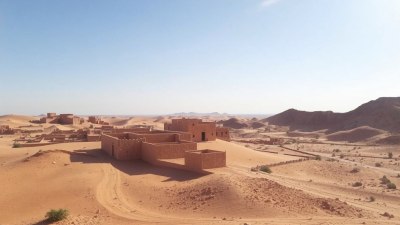The Desert Keeps Its Own Time in Tataouine, Tunisia
Discover the timeless allure of Tataouine, Tunisia, and its captivating desert landscapes.

Image created with Flux Schnell
Tataouine, a town nestled in the southern part of Tunisia, symbolizes the contrast between the rugged beauty of the desert and the deeply rooted culture of the local Amazigh communities. With its undulating dunes, stark rock formations, and ancient kasbahs, Tataouine offers an enchanting setting that feels almost otherworldly. But beyond its stunning landscape, Tataouine has its own unique rhythm, a pace defined by the vast desert that surrounds it.
The region's history dates back thousands of years, with evidence of human habitation tracing back to the Neolithic period. This long history is reflected in the architecture of the area, particularly in the traditional dwellings known as 'ksars,' which are fortified granaries built from mudbrick. The ksars of Tataouine serve as a testament to the ingenuity of the local people, who have adapted to the harsh desert conditions for centuries.
Historical Significance of Tataouine
Tataouine's strategic location made it a hub for trade routes traversing the Sahara Desert, linking North Africa to sub-Saharan regions. The town's name itself derives from the Berber term 'tatawin,' meaning 'the place where you find.' This historical backdrop enriches the character of Tataouine, drawing visitors not just for its natural beauty but also for its cultural and historical depth.
The kasbahs, or traditional fortresses, are a major attraction in Tataouine. These ancient structures served as defensive positions and storage facilities for grain and other valuable resources. Walking through the narrow streets of these ksars feels like stepping back in time, offering glimpses into the lives of the people who have called this place home for generations.
The Allure of the Desert
What truly sets Tataouine apart is its proximity to desert landscapes that stretch endlessly under the vibrant sun. The Chott el Jerid, a vast salt flat, and the Sahara Desert's immense dunes create a breathtaking backdrop that encourages contemplation and reprieve from the fast pace of modern life. The desert itself has a way of altering one’s perception of time, inviting visitors to slow down and appreciate the quietude of their surroundings.
The climate in and around Tataouine is arid, which means hot summers and mild winters. As the sun sets, the sky transforms into a palette of orange, pink, and purple hues, casting a magical glow over the desert landscape. During nighttime, the stars come alive, forming a breathtaking canopy that underscores the limitless expanse of the universe. This connection to both the earth and the cosmos contributes to the feeling that the desert indeed keeps its own time.
Cultural Heritage
The cultural heritage of Tataouine is rich and diverse. The Amazigh, or Berber, people are the indigenous inhabitants of the region, and their customs and traditions continue to influence the town's character. Festivals, music, and traditional crafts play a vital role in preserving this heritage. Visitors to Tataouine often find themselves captivated by the vibrant textiles, intricate pottery, and traditional music that embodies the spirit of the Amazigh culture.
One of the most significant cultural events in Tataouine is the annual Festival of the Amazigh Culture, which showcases local artists, musicians, and artisans. The festival serves as a platform for the community to celebrate its identity and promote awareness of their heritage. Attending this festival provides an authentic glimpse into the lives of the local residents and offers the chance to participate in traditional dance and music.
Exploring the Surrounding Areas
Beyond its immediate attractions, Tataouine serves as a gateway to explore the stunning landscapes and culturally significant sites of the surrounding areas. One of the most famous locations nearby is the Ksar Ouled Soltane, a UNESCO World Heritage site known for its impressive architecture and its role as a filming location for the original Star Wars trilogy. This site draws fans from all over the world, eager to see the film's fictional universe brought to life in the desert.
Another nearby attraction is the beautiful mountain oasis of Chenini, perched atop a hill with breathtaking views of the surrounding landscapes. The village of Chenini is a perfect example of traditional Amazigh architecture, where cave dwellings and stone structures merge seamlessly with the rocky terrain. Hiking through Chenini's valleys and discovering the hidden treasures of this oasis is a rewarding experience, offering a closer look at the harmony between the local population and nature.
Adventure Activities
For adventure enthusiasts, Tataouine offers an array of activities that allow visitors to immerse themselves in the natural wonders of the region. Camel trekking is a popular option, providing an authentic desert experience as you traverse the golden sands on the back of these magnificent animals. As the camel gently sways beneath you, the tranquility of the desert envelops you, and time seems to stand still.
Additionally, 4x4 vehicle excursions into the Sahara allow more adventurous travelers to explore remote areas inaccessible by traditional means. These tours often culminate in incredible views from higher vantage points, where one can witness the vastness of the desert stretching as far as the eye can see. Sandboarding, hot air ballooning, and stargazing sessions are also popular, creating memories that will last a lifetime.
Gastronomy and Local Cuisine
No visit to Tataouine would be complete without sampling the local cuisine. The flavors of Tunisian food reflect the melding of various cultures that have influenced the region throughout history. Dishes such as couscous, braised lamb, and tagine are staples of the local diet. The vibrant spices used in these dishes create a symphony of flavor that tantalizes the taste buds.
Street markets and local cafes offer the chance to indulge in traditional foods while mingling with locals and experiencing the warmth of Tunisian hospitality. Eating at a family-run eatery allows you to savor authentic meals prepared with love and care, showcasing the region's culinary heritage.
Preserving Nature and Culture
As visitors flock to Tataouine, it is essential to recognize the importance of sustainable tourism in preserving both the natural environment and the cultural heritage of the region. Initiatives aimed at protecting the fragile desert ecosystem and supporting the livelihood of local artisans are critical in ensuring that Tataouine remains an enchanting destination for generations to come.
Responsible tourism practices, such as minimizing waste and respecting local customs, help in maintaining the delicate balance between welcoming visitors and safeguarding the authenticity of the community. Each traveler has a role in supporting sustainable practices that benefit both the environment and the people of Tataouine.
The Magic of Tataouine
Ultimately, Tataouine is not just a destination; it is an experience that resonates deeply with those who venture into its majestic landscapes. The desert's ability to keep its own time invites introspection, urging visitors to embrace a slower pace and to find beauty in simplicity. Amidst the dunes and rocky hills, it becomes increasingly clear that Tataouine is a place where the past and present harmoniously coexist.
As you wander through the ksars, engage with the local culture, and drink in the breathtaking views, you will find that the desert's rhythm has a transformative quality. It is here in Tataouine that you can leave the hustle and bustle of modern life behind and reconnect with nature, history, and oneself. Tataouine beckons to adventurers, culture seekers, and those simply searching for a moment of tranquility—a place where the desert keeps its own time, forever etched in memory.











